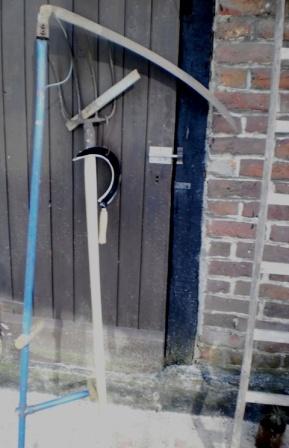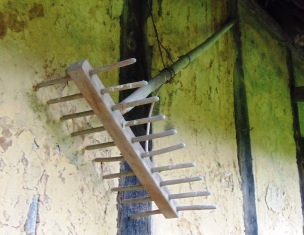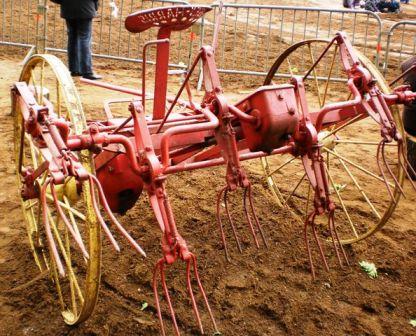 Cut tall grass, preferably not too old. Turn and shake it daily (twice) so it can dry by wind and sun. It should be fresh yellow and fragrant. In the morning you have not yet started, everything is still too wet. Let first dry the dew somewhat. Depending on the weather and the times are 2 to 5 days required. The moisture content would then only be about 15-20%.
Cut tall grass, preferably not too old. Turn and shake it daily (twice) so it can dry by wind and sun. It should be fresh yellow and fragrant. In the morning you have not yet started, everything is still too wet. Let first dry the dew somewhat. Depending on the weather and the times are 2 to 5 days required. The moisture content would then only be about 15-20%.
To turn the hay easily and operate quickly you put the clippings on rows. With a 2 sides toothed hay rake that you can lock at the handle in the desired obliquely position you work faster. Also a fork, pitchfork ( 2 or 3 teeth ) and manure fork are useful, especially to make stacks.
Hay that got wet, you can dry again, but the value is very strong declined. Instead of good food you will quickly have litter quality.
Moist stacked hay can scald (compost). It becomes so hot that a whole haystack may ignite spontaneously.
 On land, it can be temporarily stacked in hay cocks or drying racks. Cover them, possibly with a layer of combed hay to make water napping down like on a straw thatch roof. Make quite a palisade (triangular crossed pole tent) so the hay does not touch the ground. Stacking hay this way should be done carefully so that it remains firmly but also lightly to dry from under and inside. You can also make a reed or straw roof.
On land, it can be temporarily stacked in hay cocks or drying racks. Cover them, possibly with a layer of combed hay to make water napping down like on a straw thatch roof. Make quite a palisade (triangular crossed pole tent) so the hay does not touch the ground. Stacking hay this way should be done carefully so that it remains firmly but also lightly to dry from under and inside. You can also make a reed or straw roof.
Use a dry place (hay loft, roof) to save winter stock. You can create an umbrella roof, or a roof can be hoisted along the corner posts up and down. Haystacks or attics are ideal hiding places for mice. Cats also find it cozy.
Due to the low moisture content it is to keep long (over a year) because it has become more insensitive for fungi and other microorganisms. It does not matter if there are other herbs and nettles among them. Dried many animals lusts them. After more than a year, the nutritional value of hay deteriorates rapidly. It's good as long as it is fresh and smells spicy.
 Semi-dry crop (grass, corn, approximately 20-50% moisture) you can use for silage, a bit like sauerkraut. Stack it very tightly together so that all the air is out. Press firmly. Cover with plastic. So you need already a heavy tractor and big pieces of sturdy plastic. The content will sour, but delivers good food. Make sure there enters few air, even if you feed lash out. Some small pits may be more convenient than one large one. Depends also on how many cattle you have, and how much food you need daily.
Semi-dry crop (grass, corn, approximately 20-50% moisture) you can use for silage, a bit like sauerkraut. Stack it very tightly together so that all the air is out. Press firmly. Cover with plastic. So you need already a heavy tractor and big pieces of sturdy plastic. The content will sour, but delivers good food. Make sure there enters few air, even if you feed lash out. Some small pits may be more convenient than one large one. Depends also on how many cattle you have, and how much food you need daily.
Hay was for centuries the packaging material of choice. (Also about the only, in addition to straw and moss.)
A hay devil is a small whirlwind where hay is brought into a spiraling air stream. It was also called "an olde witch".
It has been mentioned that leaf hay or leaf fodder has been made from for at least 3000 years, probably before meadow hay. Leaf feed was mainly stored in mountain areas to bridge the winter and dry periods. Later also as a back-up for hay crop that can easily fail in wet summers. Deeper rooting trees with fungal wire connections also find moisture and nutrients during dry periods and times.
Young trunks (up to a maximum of 19 cm) are truncated at 2.3 m to 3.5 m. The sapwood will then usually fully overgrow into a fist form of strong 'bulging'. With an interval of 3 to 4 years, from the end of June and until July (and even September), branches (thumb thick, or smaller) are pruned with leaves and bundled tightly (without drying) with twisted ropes of hazel and willow twigs. They dry stacked. Ash (Fraxinus excelsior) and elm (Ulmus minor) appear to have been preferred. (And in an emergency even holly (Ilex aquifolium) and ivy (Hedera helix)?)
